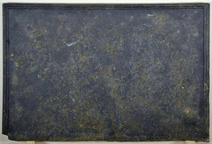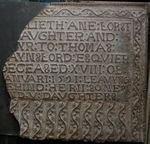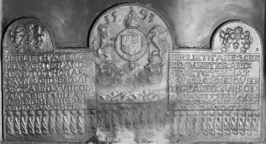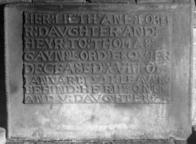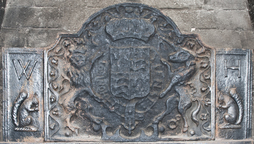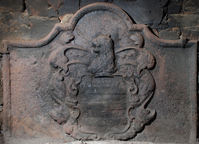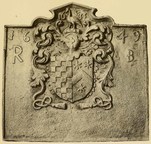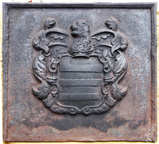-
1122
Description: Plain rectangular plate with cyma reversa, or ogee, moulding on top and sides.
Notes: A base board without other decoration. Other firebacks may have been cast using it.
- Decoration tags:
- rectangular (shape)
- cyma reversa/ogee (edging)
- carved pattern panels
Manufactured: in the 17th century in England.
Current location: 10 Garden Street, Accrington, Lancashire, England.
- Attached to series:
- Base boards
-
12
Description: Rectangular; twisted rope edging on top and sides; inscription panel with repeated trailing vine decoration from impressed wooden strips — one horizontal line at top, one vertical strip on right side (missing but probably repeated on left), at least ten short vertical strips below inscription.
Notes: Formerly at Fulling Mill Cottages, and possibly formerly at Wakehurst Place, Ardingly; it was moved to Ardingly church sometime after 1915. The inscription panel is identical to that on the memorial plate to Anne Forster in Crowhurst church, Surrey; at least ten other firebacks are known with the same inscription panel. Edward Culpeper (1561-1630), of Wakehurst, was fourth cousin, once removed, of Anne Forster. Assuming the vine strip and rope edging on the left side were of approximately the same width as on the right the overall original width of the fireback is estimated to have been 837mm.
Inscription: HER : LIETH : ANE : FORST/ R : DAVGHTER : AND : / HEYR : TO : THOMAS : / GAYNSFORD : ESQVIER / DECEASED : XVIII : OF: / IANVARI : 1591 : LEAVYNG / BEHIND : HER II : SONES : / AND : V : DAVGHTERS
- Decoration tags:
- rectangular (shape)
- rope (edging)
- carved stamps
- carved pattern panels
- planklines
- text
- plants
Manufactured: in the late-16th century possibly at Pounsley Furnace, Framfield in the Weald area of England.
Current location: St Peter's Church, Church Lane, Ardingly, West Sussex, England.
Citation: Holgate, M. S., n.d., The Parish Church of St Peter, Ardingly: Historical and Architectural Notes.
-
16
Description: Arched rectangular shape cut away with symmetrical concave curves; ovolo moulding (top and sides); shield, helmet, crest and mantling of the family of Baker, of Mayfield, quartered with Farnden, of Sedlescombe: Quarterly, 1st and 4th, Argent, a tower between three keys erect sable (Baker); 2nd and 3rd, Purpure, a chevron vairy Or and gules, between three leopards’ faces Or (Farnden). Crest (Baker): on a tower sable an arm embowed in mail holding in the hand a flint-stone proper.
Notes: A carved armorial on a plain, edged base board; John Baker (1644-1723) married Ruth, daughter and co-heiress of Peter Farnden, in 1663; she died in 1691, thereafter the arms of Baker quartered those of Farnden; the arms of Farnden had been granted in 1634. The armorial design has been inadequately pressed into the sand bed.
Copies of this fireback are known.
Arms: Baker, of Mayfield, quartering Farnden, of Sedlescombe
- Decoration tags:
- rectangular with canted top corners and round arch (shape)
- ovolo (edging)
- carved pattern panels
- armorial
Manufactured: in the early- to mid-18th century possibly at Heathfield Furnace in the Weald area of England.
Current location: Battle Museum of Local History, Battle, East Sussex, England.
- Attached to series:
- Personal armorial firebacks
- Ironmasters armorial series
-
200
Description: Composite; rectangular with semi-circular arches in middle (large) and ends (small) of top edge; rope on all edges except bottom; central panel effectively comprises an arched fireback form with Tudor royal arms (temp. Elizabeth I) with date above, and, below, letters G M, made from rope with fleur de lys terminals between two coronets surmounted by lions; below this are fronds with roses. On either side of this panel are placed the Anne Forster inscription panels; above each of these is a rose and crown with lion and dragon supporters, beneath which are three fleurs de lys. Along the base of the inscription panels and the central panel are single rows of ‘grape bunch’ shapes, beneath which are repeated trailing vine decoration from impressed wooden strips across the entire width of the fireback; 35 in all.
Notes: Formerly at Baynard's Park, Ewhurst, Surrey; GM probably refers to Sir George More, who built Baynards Park after buying the estate in 1587, and who moved to Loseley in 1604. The central coat of arms has been noted on two other firebacks, dated 1588 (no. 41) and 1595 (no. 482). The rose and crown stamps have been noted on a fireback in Haslemere Museum, and on examples illustrated by Lower (all of which bear the date 1582 and the initials IA; e.g. no. 107 or no. 472). The association of these stamps and the particular form of rope lettering, with the Anne Forster inscription and the ‘grape bunch’ shapes, both of which have been linked with other stamps from Pounsley furnace, suggests that they, too, were part of the stock of those works.
Inscription: 15 93 / GM / HER : LIETH : ANE : FORST/ R : DAVGHTER : AND : / HEYR : TO : THOMAS : / GAYNSFORD : ESQVIER / DECEASED : XVIII : OF: / IANVARI : 1591 : LEAVYNG / BEHIND : HER II : SONES : / AND : V : DAVGHTERS [twice]
Arms: Tudor royal
- Decoration tags:
- rectangular with three arches (shape)
- rope (edging)
- simple stamps
- carved stamps
- carved pattern panels
- individual letters
- individual numbers
- planklines
- heraldic
- armorial
- royal
- text
Manufactured: in 1593 possibly at Pounsley Furnace, Framfield in the Weald area of England.
Current location: not known.
Citation: Manning, O. & Bray, W., 1809, History of Surrey Vol. II (London, John White), p. 369n.
-
18
Description: Rectangular; twisted rope edging; otherwise plain plate with inscription panel centre top.
Notes: Inscription panel identical to that on the memorial plate to Anne Forster in Crowhurst church, Surrey. At least ten other firebacks are known with the same inscription panel.
Inscription: HER : LIETH : ANE : FORST/ R : DAVGHTER : AND : / HEYR : TO : THOMAS : / GAYNSFORD : ESQVIER / DECEASED : XVIII : OF: / IANVARI : 1591 : LEAVYNG / BEHIND : HER II : SONES : / AND : V : DAVGHTERS
- Decoration tags:
- rectangular (shape)
- rope (edging)
- carved pattern panels
- planklines
- text
Manufactured: in the late-16th century possibly at Pounsley Furnace, Framfield in the Weald area of England.
Current location: The Six Bells Inn, High Street, Billingshurst, West Sussex, England.
- Attached to series:
- Pounsley series
- Anne Forster series
- Epitaph firebacks
-
1244
Description: Cavetto-canted arched rectangular shape with rectangular extension panels; cavetto-moulded edging, with astragal on wide fillet edging on the extension panels; central panel, crown, shield and Garter of the Tudor royal arms but with crowned lion and unicorn supporters, all within an undulating vine border; extension panels comprise a single letter (W on left, H on right) above an inward-facing seated squirrel.
Notes: The royal arms are a hybrid of the Tudor and Stuart achievement, quite crudely modelled. The initials and squirrels both relate to the Holte family who lived at Aston Hall, which was built between 1618 and 1623. The difference in the condition of the armorial and the extensions suggest that the armorial was significantly older than the extensions. The bottom 190mm of the fireback is concealed below, behind the grate placed in front of it.
Inscription: W / HONY SOIT QUI MAL Y PENSE / H
Arms: English Tudor royal with Stuart lion and unicorn supporters
- Decoration tags:
- rectangular with canted top corners and round arch (shape)
- cavetto (edging)
- carved stamps
- carved pattern panels
- extension panels
- heraldic
- armorial
- royal
- text
- animals
Manufactured: in the mid- to late-17th century in England.
Current location: Aston Hall, Aston, West Midlands, England.
(part of the Birmingham Museums Trust museum group)
- Attached to series:
- Stuart royal armorial firebacks
-
913
Description: Rectangular with an arched rectangular style arch linked by symmetrical concave curves; ovolo moulding (top and sides); shield, helm, crest and mantling of the Fuller family. A number 7, the only visible part of the date seen on other castings is in the top right corner of the shield.
Notes: A carved armorial on a plain, edged base board; the arms of the Fullers of Brightling Park, Sussex: Argent, three bars and a canton gules; the crest; Out of a ducal coronet Or, a lion’s head argent; the Fullers were iron masters and gun founders in the first half of the 18th century, operating Heathfield furnace, where it is likely that this fireback was cast.
Inscription: [1] 7 / [4] [7]
Arms: Fuller, of Brightling, Sussex
- Decoration tags:
- rectangular with round arch (shape)
- ovolo (edging)
- carved pattern panels
- armorial
Manufactured: in 1747 probably at Heathfield Furnace in the Weald area of England.
Current location: in private hands, Brightling, East Sussex, England.
- Attached to series:
- Ironmasters armorial series
- Personal armorial firebacks
-
831
Description: Rectangular with small detached pediment; cavetto-moulded edging; upper centre, shield, helm, crest and mantling, with date, 1635, split either side of crest; top, date, 1649, split either side of armorial; initials split either side of armorial, below date.
Notes: The armorial, tentatively associated with the family of Brooke or Broke of Madeley, Shropshire (blazon: chequy argent and sable, impaling a chevron between three estoiles), dated 1635, was formed from a pattern designed for a smaller fireback (see no. 917), but positioned on a larger backing board with the later date and initials added separately, most of the frame of the original fireback being pared away. From an illustration in the catalogue of an exhibition on heraldry at Burlington House, London, in 1894.
Inscription: 16 35 / 16 49 / R B
Arms: poss. Brooke or Broke of Staffordshire
- Decoration tags:
- rectangular with detached pediment (shape)
- cavetto (edging)
- carved stamps
- carved pattern panels
- composite
- individual letters
- individual numbers
- armorial
- text
Manufactured: in 1649 in England.
Current location: not known.
- Attached to series:
- Personal armorial firebacks
- Composite firebacks
-
621
Description: Rectangular; ovolo moulded edging (top and sides); central shield, crest and mantling of the Fuller family. The date, of which the 1 is not visible, is split between the top corners of the shield and about two-thirds of the way down.
Notes: A carved armorial on a plain, edged base board; the arms of the Fullers of Brightling Park, Sussex, are: Argent, three bars and a canton gules; the crest; Out of a ducal coronet Or, a lion’s head argent. The Fullers were iron masters and gun founders in the first half of the 18th century, operating Heathfield furnace, where it is likely that this fireback was cast.
Copies of this fireback are known.
Inscription: [1] 7 / 4 7
Arms: Fuller, of Brightling, Sussex
- Decoration tags:
- rectangular (shape)
- ovolo (edging)
- carved pattern panels
- heraldic
- armorial
- text
Manufactured: in 1747 probably at Heathfield Furnace in the Weald area of England.
Current location: in private hands, Butleigh, Somerset, England.
- Attached to series:
- Ironmasters armorial series
- Personal armorial firebacks
-
247
Description: A modified recasting of a variant of the ‘Armada’ fireback, with initials changed to IK, a single anchor panel, and the addition of a plain base and borders, the latter each with a twisted rope saltire, upper middle.
Notes: It is likely that an original four-panel fireback has been used to recast a copy with additional side and base panels; the saltires may have apotropaic significance. A second fireback at the house cast in the 19th century is identical but for being 1% smaller all round, and has a full-width extension on top bearing four symmetrical rope saltires, the outer two larger than the inner two. The first example was used to make the second.
Inscription: 1588 / IK
- Decoration tags:
- rectangular with round arch (shape)
- simulated rope (edging)
- simple stamps
- carved pattern panels
- composite
- extension panels
- apotropaic
- text
- plants
- objects
Manufactured: in the 17th century in the Weald area of England.
Current location: Chawton House, Chawton, Hampshire, England.
- Attached to series:
- Armada series
